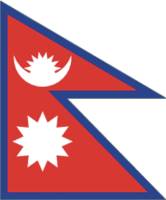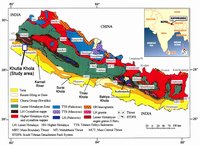Special Program for International Students
GRADUATE COURSE IN EARTH SCIENCE
& GEOENVIRONMENTAL SCIENCE
Current students


Swostik Kumar Adhikari (Nepal)
Email: swostik_adhikari@hotmail.com
Thesis title: Comparison of sedimentological, geochemical and petrographical variations in two differing river systems of the Neogene Siwalik Group, Nepal Himalaya; in relation to provenance, paleoclimate and Himalayan tectonics.
Supervisor: Assoc. Prof. Tetsuya Sakai (2014-2017).
The Siwalik Group, known as the molassic sediments exposed in association with Himalayan uplift, was deposited during the middle Miocene to the early Pleistocene as a 4 – 6 km thick succession of fluvial sediments at the southern front of the entire Himalayan belt. The Siwalik Group has been traditionally subdivided into three units which are the Lower, Middle and Upper Siwaliks (Auden, 1935; Hagen, 1969; Yoshida and Arita, 1982; Quade et al., 1995; DeCelles et al., 1998; Gautam and Fujiwara, 2000; Ojha et al., 2000; Robinson et al., 2006; Sharma et al., 2007) and locally modified subdivisions into up to five subunits have been applied (Glennie and Ziegler, 1964; Sharma, 1973; Tokuoka et al., 1986, 1988; Sah et al., 1994; Corvinus and Nanda, 1994; Dhital et al., 1995; Ulak and Nakayama, 1998; Sigdel et al., 2011). The common three-fold classification starts in general with the mudstone-dominated Lower Siwalik, grading upward into the sandstone-dominated Middle Siwalik and the Upper Siwalik with conglomerate-dominated sediments.
This study focuses on the fluvial facies, geochemistry and petrography of sedimentary rocks of the Siwalik Group in the Khutia Khola section, Far Western Nepal. Previous studies indicated the presence of a much more extensive succession of finegrained mudsized sediments in the Khutia Khola section (Quade et al., 1995; Ojha et al., 2000; Sharma et al., 2007) than in other Siwalik successions (cf. Tokuoka et al., 1986, 1988; Sah et al., 1994; Corvinus and Nanda, 1994; Dhital et al., 1995; Ulak and Nakayama, 1998; Sigdel et al., 2011). This muddy succession provides a much better archive than the sand-dominated successions because the loss of sediment by stream erosion will be smaller than in the sand-dominated units, and the sediments may provide a good example of interfluve environments of the Siwalik phase. The results from the Khutia Khola are compared to those from equivalent sediments in the adjacent Karnali River section, which are known to have been deposited by the large paleo-Karnali River system. The Siwalik deposits in these two sections are important records of Himalayan Uplift and the related climatic and environmental changes in the western part of the Nepal Himalaya. A detailed comperative study of these sediment records will improve our understanding of these key processes during Neogene period and their effects on a regional and global scale.
REFERENCES
Auden, J. B., 1935, Traverses in the Himalaya. Records of the Geological Survey of India. v. 69, pp. 123-167.
Corvinus, G. and Nanda, A. C., 1994, Stratigraphy and paleontology of the Siwalik group of Surai Khola and Rato Khola in Nepal. N. Jb. Geol. Palaont. Abh., v. 191, pp. 25-68.
DeCelles, P. G., Gehrels, G. E., Quade, J., Ojha, T. P., Kapp, P. A. and Upreti, B. N., 1998, Neogene foreland basin deposits, erosional unroofing, and the kinematic history of the Himalayan fold-thrust belt, western Nepal. Jour. Geol. Soc. Am. Bull., v. 110, pp. 2-21.
Dhital, M. R., Gajurel, A. P., Pathak, D., Paudel, L. P. and Kizaki, K., 1995, Geology and structure of the Siwaliks and Lesser Himalaya in the Surai Khola-Bardanda area, Mid Western Nepal. Bull. Dept. Geol. Tribhuvan Univ., v. 4, pp. 1-70.
Gautam, P. and Fujiwara, Y., 2000, Magnetic polarity stratigraphy of Siwalik Group sediments of the Karnali River section in western Nepal. Geophys. Jour. Intern., v. 142, pp. 812-824.
Glennie, K. W. and Ziegler, M. A., 1964, The Siwalik Formations of Nepal. Int.. Geol. Congr., 22, Delhi, v. 25, pp. 82-95.
Hagen, T., 1969, Report on the Geological Survey of Nepal: Preliminary Reconnaissance. Denkschr. Naturw. Ges. v. 86, 185 p.
Ojha, T. P., Butler R. F., Quade, J., DeCelles, P. G., Richards, D. and Upreti, B. N., 2000, Magnetic polarity stratigraphy of the Neogene Siwalik Group at Khutia Khola, far western Nepal. Jour. Geol. Soc. Am. Bull., v. 112, pp. 424-434.
Quade J., Cater, J. M. L, Ojha, T. P., Adam J. and Harrison, T. M. 1995, Late Miocene environmental change in Nepal and the northern Indian subcontinent: Stable isotope evidence form paleosols. Jour. Geol. Soc. Am. Bull., v. 107, pp. 1381-1297.
Robinson, D. M., DeCelles, P. G. and Copeland, P., 2006, Tectonic evolution of the Himalaya thrust belt in western Nepal: Implication for channel flow models. Jour. Geol. Soc. Am. Bull., v. 118, pp. 868-885.
Sah, R. B., Ulak, P. D., Gajurel, A. P. and Rimal, L. N., 1994, Lithostratigraphy of the Siwalik sediments of the Amlekhganj-Hetauda area, sub-Himalaya of Nepal. Him. Geol. v. 15, pp. 37-48.
Sharma, C. K., 1973, Geology of Nepal. Education Enterprises, Kathmandu. 164 p.
Sharma, S. R., Subedi, D. N., KC, S. B., Khanal, R. P., Tripathi, G. N., 2007, Geological Map of Petroleum Exploration Block-1, Dhangadi, Far Western Nepal (Scale: 1:250,000). Petroleum Exploration Promotion Project, Department of Mines and Geology, Kathmandu, Nepal.
Sigdel, A., Sakai, T., Ulak, P. D., Gajurel, A. P. and Upreti, B. N., 2011, Lithostratigraphy of the Siwalik Group, Karnali River section, far-west Nepal Himalaya. Jour. Nepal Geol. Soc., v. 43, pp. 83–101.
Tokuoka, T., Takayasu, K., Yoshida, M. and Hisatomi, K., 1986, The Churia (Siwalik) Group of the Arung Khola area, West Central Nepal. Mem. Fac. Sci. Shimane Univ., v. 20, pp. 135-210.
Tokuoka, T., Takeda, S., Yoshida, M. and Upreti, B. N., 1988, The Churia (Siwalik) Group in the Western Part of the Arung Khola area, west central Nepal. Mem. Fac. Sci. Shimane Univ. v. 22, pp. 131-140.
Ulak, P. D. and Nakayama, K., 1998, Lithostratigraphy and evolution of the fluvial style in the Siwalik Group in the Hetauda-Bakiya Khola area, Central Nepal. Bull. Dep. Geol., Tribhuvan Univ., v. 6, pp. 1–14.
Upreti, B. N. and Le Fort, P., 1999, Lesser Himalayan crystalline nappes of Nepal: Problems of their origin, in Macfarlane, A., Sorkhabi, R. B., and Quade, J., (eds.), Himalaya and Tibet: Mountain Roots to Mountain Tops. Geol. Soc. Am., v. 328 (Sp. Paper), pp. 225-238.
Yoshida, M. and Arita, K., 1982, On the Siwaliks observed along some routes in Central Nepal. Jour. Nepal Geol. Soc., v. 2, (Sp. Issue), pp. 51-58.
